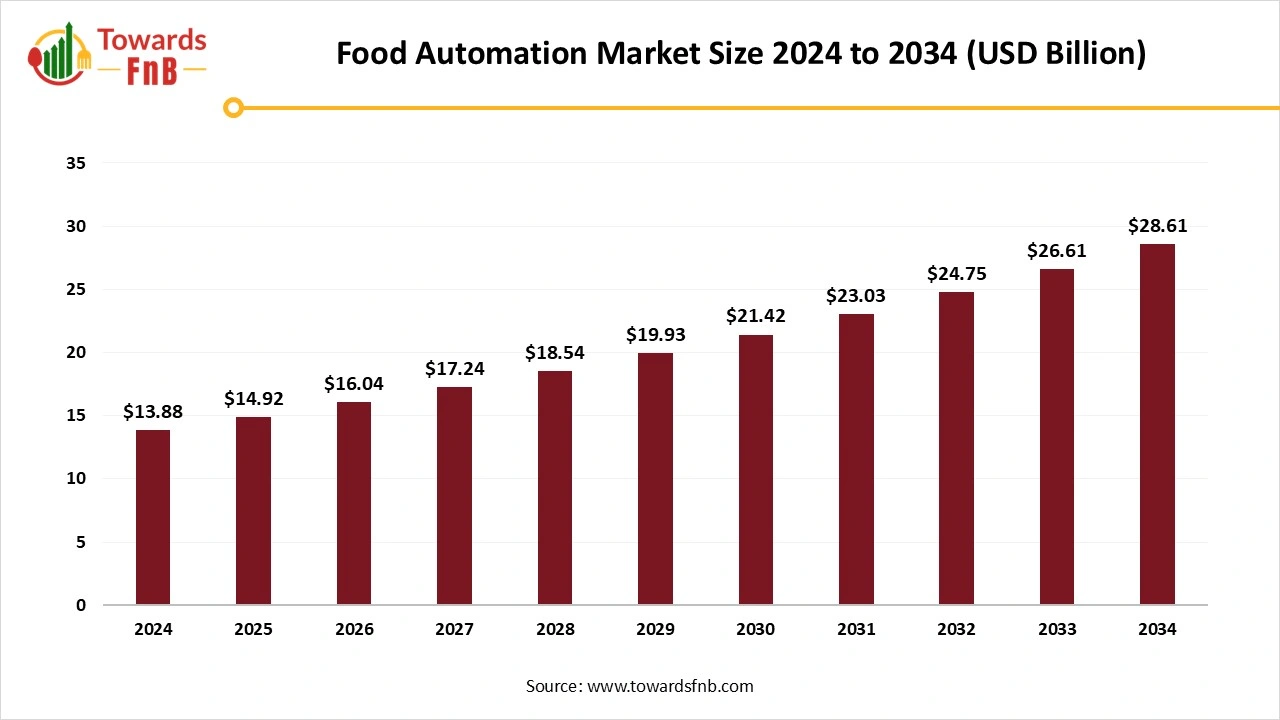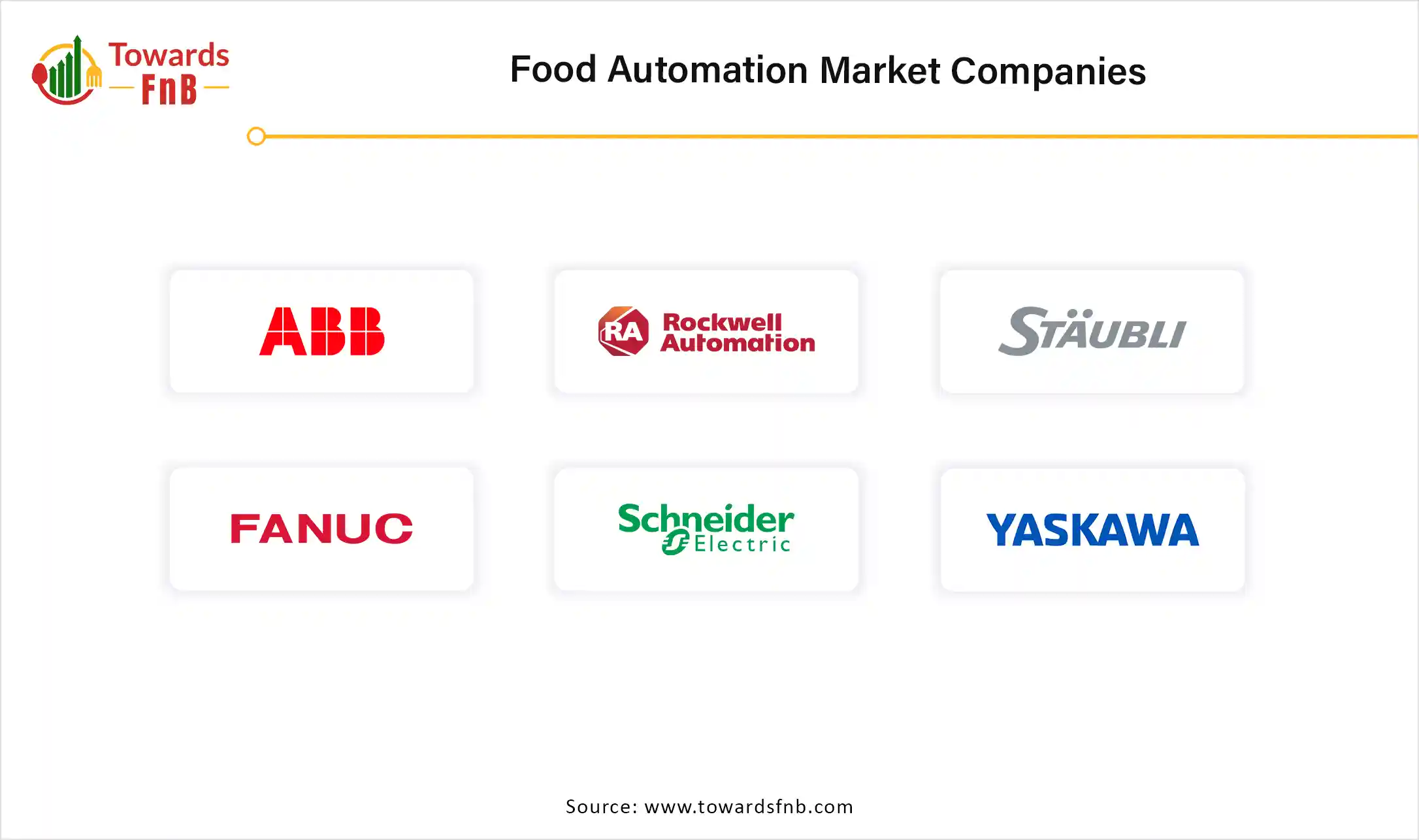December 2025
The global food automation market size was reached at USD 13.88 billion in 2024 and is expected to grow steadily from USD 14.92 billion in 2025 to reach nearly USD 28.61 billion by 2034, with a CAGR of 7.5% during the forecast period from 2025 to 2034. Rising population, increasing demand for the processed food and technological advancements such as artificial intelligence and robotics significantly expanding the market.

| Study Coverage | Details |
| Growth Rate from 2025 to 2034 | CAGR of 7.5% |
| Market Size in 2025 | USD 14.92 Billion |
| Market Size in 2026 | USD 16.04 Billion |
| Market Size by 2034 | USD 28.61 Billion |
| Largest Market | North America |
| Base Year | 2024 |
| Forecast Period | 2025 to 2034 |
| Regions Covered | North America, Europe, Asia-Pacific, Latin America, and Middle East & Africa |
The automation of the food sector involves managing machinery, and every operation must be sustained by autonomous systems utilizing different technologies that rely on computer software or robotics for increased efficiency. Due to the ongoing rise in the global population and enhanced living conditions, the demand for food has shown an extraordinary growth path. Worldwide food demand might rise by 59-98% by the year 2050. Consequently, the food sector exploring creative solutions to satisfy the increasing demand for food while maintaining quality and safety standards which is rising the market.
Automation technology enhances the intelligence of the production line, allowing the entire manufacturing process to occur without human involvement, which not only minimizes manual operation errors but also stabilizes and refines the production process. Consumer preferences for processed and convenient foods because of rising disposable income, busy lifestyle and urbanization, emphasize the importance of boosting operational efficiency and productivity in food processing and therefore fostering the food automation market.
In the constantly evolving technology landscape, vendors need to rapidly adjust and discover ways to transform their operations to meet shifting customer expectations and the increasingly competitive marketplace. Automation within the food sector can assist businesses in safeguarding their brand by maintaining uniformity in product quality and safety, enhancing customer satisfaction, and minimizing the chances of product recalls or other problems that could harm the company's reputation.
The upfront expense of adopting automated solutions is significant. The upfront expense of combining various technologies such as AI, IoT, and RPA can be extremely expensive, particularly for small and medium-sized businesses. Moreover, the intricate nature of these technological implementation implies that businesses could encounter concealed expenses linked to integration, staff training, and continual system upkeep.
North America Dominated the Food Automation Market in 2024.
Significant factors thar are propelling the market growth are reduction of labor costs, guaranteeing food safety, enhanced production speed, and the incorporation of artificial intelligence and machine learning in food automation systems. Stringent food safety regulations and the increasing demand for personalized food items driving the need of automation in food production. Furthermore, the emerging trend of sustainability, which emphasizes reducing waste and energy consumption, is another prominent factor contributing for market expansion. Rising demand for the packaged and processed food, increasing fast food industry, restaurants, cafes are utilizing the automated kitchen and boosting the food automation.
Food Automation Market of United States
United states food automation market experienced robust growth. This market is primarily shaped by the nation's constant need for packaged goods, resulting in improved manufacturing, operational, and distribution methods. Producers are incorporating AI and machine learning into robots, allowing them to carry out intricate tasks like sorting, packaging, and quality assessment with great accuracy. With increasing consumer demand for tailored food products and quicker delivery, robotics is addressing these requirements by enhancing production efficiency and personalization. FDA has finalized various regulations to implement Food Safety Modernization Act, to ensure food safety and quality which is expanding the food automation to comply with safety and quality regulations.
Asia Pacific Expects the Significant Growth in the Market During the Forecast Period.
The food automation sector in the Asia Pacific is growing significantly due to swift industrialization, urban growth, and increased demand for packaged and processed food products. By 2030, Asian consumers are anticipated to double their food expenditures, generating a USD$8 trillion market and establishing the largest food and beverage market globally and boosting the food automation market. The growing demand for packaged foods with heightened food safety regulations, and the necessity for more efficient production lines are key factors fueling growth. Nations like China, South Korea, and Japan lead the way, significantly investing in robotics to improve productivity and efficiency in food production and processing. Japan has consistently led in robotics and automation, and their recent $7.8 million funding for AI-driven culinary robots is poised to transform the food service sector.
Food Automation Market of India
Food automation market of India is evolving swiftly. The food processing sector in India is experiencing a significant transformation with implementation of automation. The drive for greater efficiency, reduced costs, and enhanced productivity has resulted in the extensive use of automation technologies. Moreover, progress in AI and machine learning has also accelerated market growth. Automation and robotics are transforming food and beverage manufacturing by optimizing processes, lowering labor expenses, and guaranteeing product safety. Robotic arms equipped with AI are currently managing intricate tasks like packaging, sorting, and quality assurance. Sophisticated automated surveillance systems monitor environmental conditions instantaneously to preserve product quality.
Urbanization, in turn, is causing a significant change in consumption patterns, with an increasing demand for convenience food and packaged meals. Various government initiatives and program supporting food manufacturers to integrate automation and helping to boost the market. The Ministry of Food Processing Industries (MoFPI) organized World Food India 2024 in New Delhi. The Technology Pavilion in event showcased innovative developments in food processing, concentrating on automation, food safety, and eco-friendly packaging options.
Motors and Generators Segment Dominated the Food Automation Market with the Largest Share in 2024.
The increasing demand for automation in food sector such as manufacturing, processing packaging is boosting the need for high-performance motors and generators. Motors utilized in the food automation frequently exhibit specific and rigorous needs in areas like meat, poultry and fish, dairy products, and baked goods, along with uses in devices such as grinders, mixers, and conveyors. Machines must function flawlessly, for extended periods, while maintaining the highest level of energy efficiency during their entire lifespan. Generators and motors are the energetic pair driving the automation revolution. In robotic manufacturing lines, motors convert complex algorithms into accurate motions, facilitating smooth product assembly with little human involvement. Generators ensure a reliable power source for these robots, avoiding interruptions that might disturb the fragile equilibrium of the manufacturing process.
Motor Controls Segment is Observed to Grow at the Fastest Rate During the Forecast Period.
Motor controls are vital due to their widespread use in numerous stages of food processing. Motor controls play a crucial role in regulating the speed, torque, and positioning of equipment utilized in food manufacturing. Automation systems utilizing sophisticated motor control technologies allow for accurate handling and processing of food products, essential for preserving product quality and uniformity.
Meat, Poultry, and Seafood Segment Held the Largest Share of the Food Automation Market in 2024.
The consumption of meat is broadly recognized as a crucial provider of essential nutrition for people globally. In response to the increased demand for meat, around 80 billion animals are slaughtered each year, leading to a substantial rise in the meat processing workload. This rapid expansion drove the meat sector's growing demand for greater productivity and efficiency, leading to a faster rise in the automation market throughout the meat industry. The use of automation in the fish processing sector leads to enhanced efficiency. Manufacturers of seafood processing machinery are diligently creating automated machinery aimed at lowering labor expenses, saving energy, and minimizing health hazards.
Dairy Segment is Seen to Grow at a Notable Rate During the Predicted Timeframe.
With increasing consumer demand for dairy items, boosted by increased population, surged awareness of the health advantages related with dairy expanding the dairy industry and demand automation to make all dairy processing easy and convenient. Automation aids dairy farmers and processors complete consumer demands by smooth running different steps the production process, from milking cows to processing and packaging the final item. Animal welfare and sustainability trend further boosting the dairy automation.
Packaging Segment Led the Food Automation Market in 2024.
Growing consumer preference and demand for packaged goods is boosting the need for automation in packaging. Automation in food packaging optimizes the packing procedure by employing industrial robots to quickly sort and seal products. Historically, most food processing companies depended on numerous human employees to carry out these duties. Companies can now boost production levels while reducing expenses on labor costs. Packaging firms are transforming their customer base by providing personalized product packaging, leading to a rise in demand for machines with tailored components. Well-known food and drink retail brands such as Domino's, Burger King, and McDonald's are generating demand for comparable personalization, showcasing their skills in distinctive packaging designs which is fostering the demand for automation.
Processing Segment is Expected to Grow at the Fastest Rate in the Market During the Forecast Period.
Advancements in food processing technology, an increase in demand for processed foods, and growing research and development in food processing equipment are anticipated to propel the market in the coming years. Automated systems can be created to reduce the likelihood of cross-contamination and guarantee that food is managed and processed securely and hygienically, thus lowering the risk of foodborne diseases. Automating food production enables food processing equipment manufacturers to sustain production standards, reduce waste, and enhance efficiency, thereby freeing time for other aspects of their business.
Chef Robotics
Manter

By Type
By Application
By Function
By Region
December 2025
November 2025
November 2025
November 2025